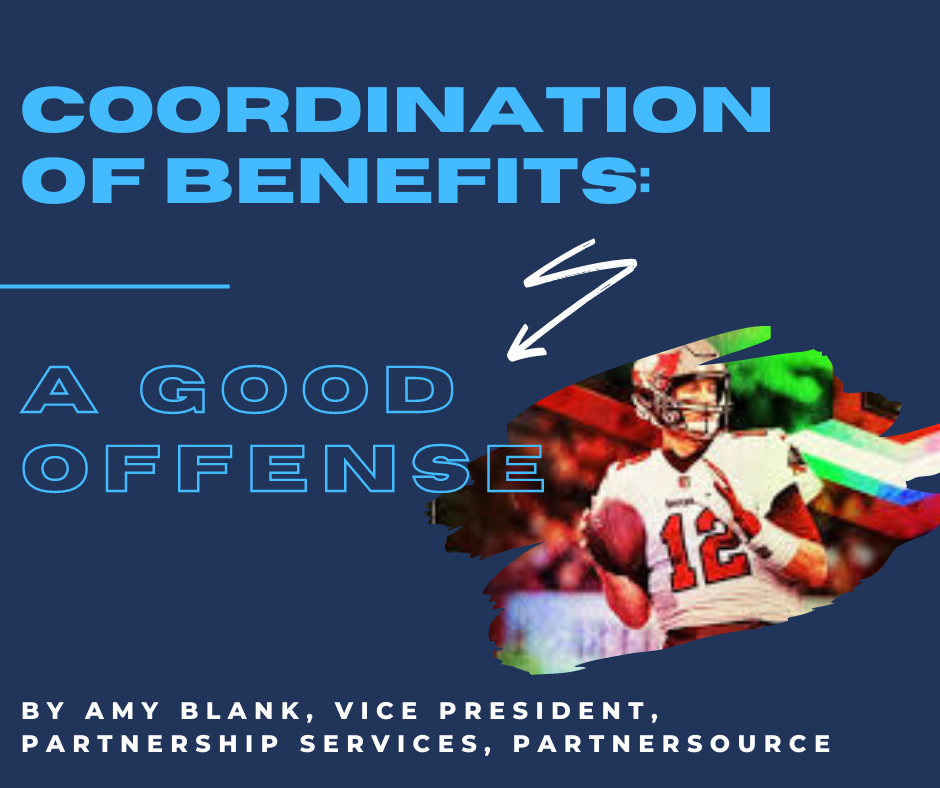
Coordination of Benefits: A Good Offense
By Amy Blank, Vice President, PartnerShip Services
Did you see the "Big Game"? Watching two legendary quarterbacks, Tom Brady and Patrick Mahomes, lead their teams drives home how important it is to have a strong offense in order to cross the goal line. Last month, my colleague Kelly Norwood reviewed the keys to playing a good defense, an important part to a successful Texas injury benefit program. As we all know, playing defense is only half the equation of having a winning team.
Today, I will review ways in which a great offense will allow you to achieve the best possible outcomes for your injury benefit program while providing excellent benefits for the participants:
Be the quarterback. In football, a great offense is led by a great quarterback. To run a good offense for an injury benefit plan, the claim administrator’s role is to quarterback the administration of plan benefit. This means this person needs to have mastery of the offensive options, the ability to view the entire field and find the open receiver, and demonstrate leadership of the team with superior communication and by making wise decisions. When that is done proactively, using all available tools and resources, the result is a superior outcome for all involved.
Understand the plays and rules. A quarterback who doesn’t know the plays or rules doesn’t stand a chance in winning a game, so a good offense begins with knowledge. This is also important in order to meet fiduciary requirements under ERISA. For a benefit program, this is achieved by knowing the benefit plan to ensure that injured workers are receiving the benefits allowed under the plan. This also means applying the boundaries outlined in the plan so that benefits are only provided for covered injuries. Learn where to find relevant plan boundaries (hint: the table of contents is a game changer!) and be familiar with ERISA guidelines to ensure important deadlines are met. When necessary and when allowed, using an extension of a timeframe is the right play. Finally, effectively communicating plan boundaries to the injured worker will enable employees to maximize their benefits and leads to fewer disputes.
Know your team. As the quarterback, you must recognize that you can’t fulfill every role on the team yourself, and that a good offense results from knowing what resources are available. For example, using evidence-based medicine to support plan decisions is a good strategy and utilizing nurse case management, specialist physicians, and independent medical opinions can ensure better medical outcomes for employees and that the boundaries of the plan are enforced. Additionally, when a complex claim occurs, taking a quick time out to meet with medical and legal resources will ensure the best outcome. A good quarterback understands the importance of treating the whole person: pro-actively addressing factors inhibiting recovery from an injury, such as transportation or challenges in the home environment, can help develop solutions that clear the path for an employee to get better.
Demonstrate your ability to lead. All great quarterbacks inspire their team and those around them. I strongly believe that an endpoint in a claim for benefits is the greatest area of opportunity we have to exercise a skilled offense while also protecting injured employees. A strong leader in claim administration will first ensure that injured employees receive 100% of reasonable and necessary medical treatment and better wage replacement benefits. On rare occasions when the claim for covered benefits is at an endpoint with non-covered conditions remaining, lead the employee toward a positive resolution by:
1. Helping the injured worker understand the plan decision.
2. Clearly explain the science supporting it (also an ERISA requirement).
3. Have a detailed "Game Plan" of other options.
It is important to communicate with injured employees in a respectful way in both verbal and written communication. Having a conversation at the endpoint of benefits to explain the decision will help to humanize the experience and give the employee an opportunity to ask questions. Proactive coordination of benefits involves being on the ball in identifying other benefit options and planning smooth transitions between various plans or programs that may assist an injured worker, especially when a coverage boundary is about to be crossed. Having and presenting options is key to diffusing heightened emotions and will let employees know they are cared for.
Run a post-game analysis. All great teams (and their fans) evaluate the misses and successes the morning after the game. If your program is running a good offense, you will see a low appeal rate, a low litigation rate and low program expense ratios. If you find one or more of these is high, evaluate your plan’s offense strategy to improve your program, save costs and improve employee satisfaction. And always feel free to call in special teams—PartnerSource, for example—to up your game and win championships.
